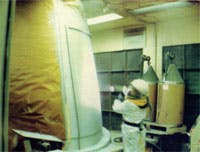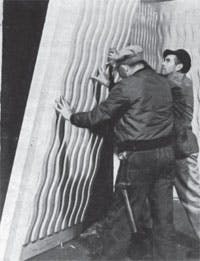10 YEARS AGO — 2001
Electronic brakes note telltale signs of panic: The Mercedes-Benz SL coupe/roadster uses a computer to tell four valves exactly how hard to hit the brakes. An electrically driven hydraulic pump and high-pressure reservoir help put full brake pressure at each wheel, eliminating bulky vacuum-brake boosters.
The brakes recognize early signs of an emergency and react. Pressure in the brake connectors rises, moving the pads onto the discs, permitting instant reaction when the brakes are pressed.
30 YEARS AGO — 1981
New way to make big plastic parts: Molds for plastic aircraft components can be rapidly and economically produced by a new method, says TAFA Metallisation Inc., Bow, N. H. Based on high-velocity arcspraying, the process is intended for large (over 100 ft2) prototype molds for runs of 400 to 500 units and molds for production runs up to 20,000 units, depending on pressure and temperature. The process can be used for composites, vacuum forming, rotational molding, SMC, RIM tooling, and injection molding. Molds are formed by spraying zinc on model material, such as wood, plastic, leather, and wax, to exactly reproduce both shape and finish. With arcspray, zinc can be applied at 30 lb/hr and a mold-wall thickness of 1/8 in. can be built up rapidly. The metal shell is then backed by a special laminating paste with compatible expansion characteristics.
50 YEARS AGO — 1961
Plastic sandwiches in a new refrigerated freight car can maintain any temperature from –10 to 70°F. The three-layer panels which line the car are made of Cycolac polymer, a rigid ABS plastic from Marbon Chemical Div. of Borg-Warner Corp.; Dylite expandable polystyrene insulation from Koppers Co.; and a ¼-in. plywood back. These panels reduce weight of the refrigerator car and, because they are only 6½-in.-thick, add 451 ft3 of space to the car’s capacity.
About the Author
Sign up for our eNewsletters
Get the latest news and updates



